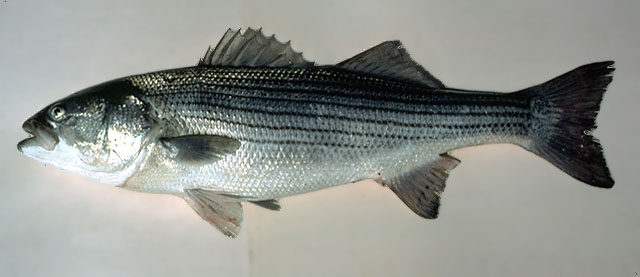| Moronidae (Temperate basses) |
| 200 cm TL (male/unsexed); max.weight: 57 kg; max. reported age: 30 years |
|
demersal; freshwater; brackish; marine; depth range - 30 m, anadromous |
| Western Atlantic: St. Lawrence River in Quebec, Canada to Lake Pontchartrain in Louisiana; south in Florida, USA to St. Johns and Suwannee river drainages. |
|
Dorsal spines (total): 9-11; Dorsal soft rays (total): 10-13; Anal spines: 3-3; Anal soft rays: 7-13 |
| Inhabit coastal waters and are commonly found in bays but may enter rivers in the spring to spawn (Ref. 2850). Some populations are landlocked (Ref. 7251). Voracious and opportunistic feeder (Ref. 5951). Larvae feed on zooplankton; juveniles take in small shrimps and other crustaceans, annelid worms, and insects (Ref. 1998, 10294); adults feed on a wide variety of fishes (alewives, herring, smelt, eels, flounders, mummichogs, rock gunnels, sand lance, silver hake and silversides (Ref. 5951)) and invertebrates (squid, crabs, sea worms and amphipods (Ref. 5951)), mainly crustaceans (Ref. 1998). Feeding ceases shortly before spawning (Ref. 1998). Utilized fresh and eaten broiled and baked (Ref. 9988). |
|
Least Concern (LC); Date assessed: 03 February 2019 Ref. (130435)
|
| harmless |
Source and more info: www.fishbase.org. For personal, classroom, and other internal use only. Not for publication.
